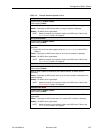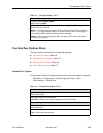
Configuration Option Tables
A-6
7610-A2-GB20-10November 1997
Table A-2. Network Interface Options (2 of 4)
IMC IP Address
Possible Settings: 000.000.000.000 – 223.255.255.255, Clear
Default Setting: 000.000.000.000
Specifies the Internet Protocol address used to access the unit via the IMC interface.
H IMC IP Address option does not appear when the In-Band Management Channel
Rate (bps) is disabled.
000.000.000.000 – 223.255.255.255 – The range for the first byte is 000 to 223, with the
exception of 127. The range for the remaining three bytes is 000 to 255.
Clear – Clears the IMC IP address and sets to all zeros.
IMC Subnet Mask
Possible Settings: 000.000.000.000 – 255.255.255.255, Clear
Default Setting: 000.000.000.000
Specifies the subnet mask used to access the unit via the IMC interface.
H IMC Subnet Mask option does not appear when the In-Band Management
Channel Rate (bps) is disabled.
000.000.000.000 – 255.255.255.255 – Set the IMC interface subnet mask. The range
for each byte is 000 to 255.
Clear – Clears the IMC Subnet Mask and sets to all zeros. When the subnet mask is all
zeros, the device creates a default subnet mask based on the class of IP address:
– Class A defaults to 255.000.000.000
– Class B defaults to 255.255.000.000
– Class C defaults to 255.255.255.000
IMC Routing Information Protocol
Possible Settings: None, Proprietary
Default Setting: Proprietary
The RIP routes IMC management information between devices.
H IMC Routing Information Protocol does not appear when the In-Band Management
Channel Rate (bps) option is disabled.
None – No routing protocol.
Proprietary – Uses proprietary variant of RIP Version 1 to enable the routing of
IP traffic between Paradyne devices.
Cross Pair Detection Alarm
Possible Settings: Enable, Disable
Default Setting: Enable
When a crossed pair condition is detected on the network interface, an ASCII alarm is
generated.
H Cross Pair Detection Alarm option appears when the Operating Mode is set to
DDS in Table A-1.
Enable – Generates an ASCII alarm when a crossed pair condition is detected.
Disable – No ASCII alarm is generated.
NOTE: Additional settings are required to send out an ASCII alarm. Refer to the
Alarm Messages
section in Chapter 8.


















